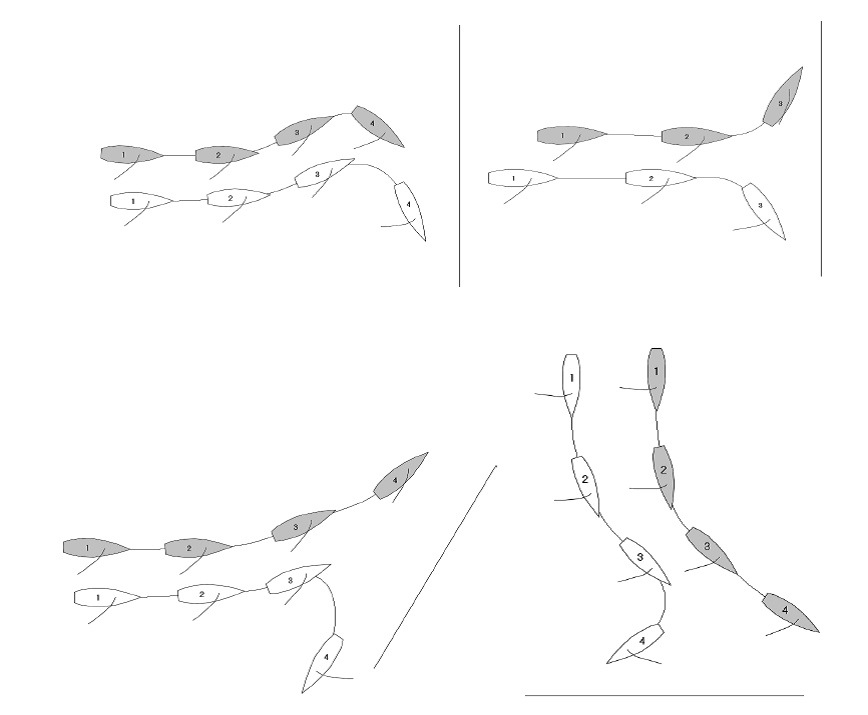







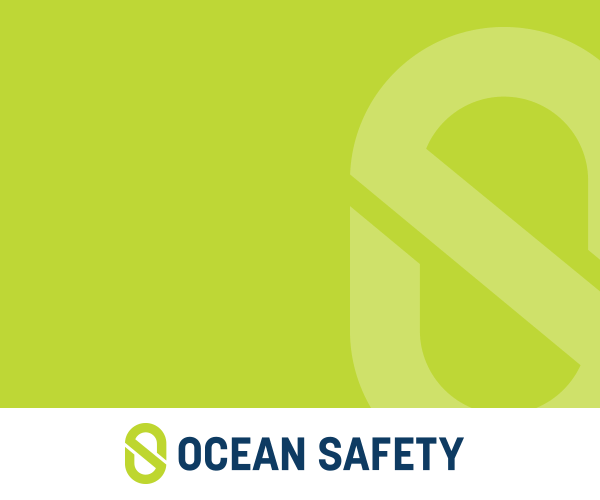
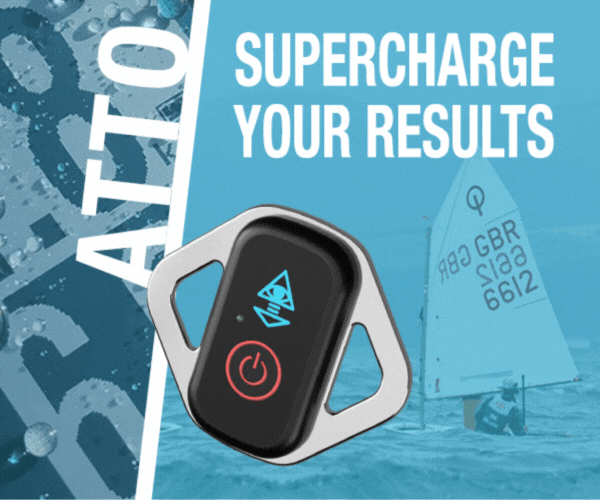



| Rossiter Pintail Mortagne sur Gironde, near Bordeaux |
 |
| Laser 28 - Excellent example of this great design Hamble le rice |
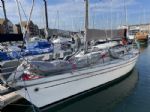 |
List classes of boat for sale |
Inside and outside at an obstruction. |
Post Reply 
|
Page 123> |
| Author | |
SteveB00 
Newbie 
Joined: 30 Nov 13 Location: Sydney, Oz Online Status: Offline Posts: 24 |
 Post Options Post Options
 Quote Quote  Reply Reply
 Topic: Inside and outside at an obstruction. Topic: Inside and outside at an obstruction.Posted: 11 Jan 14 at 1:19am |
|
A boat, L, is reaching on starboard tack towards a mark of the course that is at the left hand end of an island. However, it's the not the island, but a navigation mark just off the end of it that is listed as the mark. I believe that makes the island a continuing obstruction. A bigger, slightly faster boat, W, catches L and forms an overlap to windward of her. L comes up until the boats are sailing straight at the island. The shore is a gradually shoaling beach and, while the boats are roughly abeam of each other, the bigger boat, W, starts to run out of water, while L still has enough water to sail further before needing to bear away for the mark. My instinct is that rule 19(b) should compel L to bear away and make room for W to sail between her and the island but, while the boats are sailing directly at the island, in what sense are the boats "outside" and "inside"? To take it further, if L sailed high enough, she would appear to be the "inside" boat and W the "outside". When W runs out of water, what compels L to bear away and allow W to pass the obstruction? Thanks in advance, Steve = : ^ ) |
|
 |
|
Presuming Ed 
Really should get out more 
Joined: 26 Feb 05 Location: United Kingdom Online Status: Offline Posts: 641 |
 Post Options Post Options
 Quote Quote  Reply Reply
 Posted: 11 Jan 14 at 5:15pm Posted: 11 Jan 14 at 5:15pm |
|
Can someone quote 19.2.c. On my phone & can't cut and paste from a PDF.
I assume the island is to windward? |
|
 |
|
JimC 
Really should get out more 

Joined: 17 May 04 Location: United Kingdom Online Status: Offline Posts: 6661 |
 Post Options Post Options
 Quote Quote  Reply Reply
 Posted: 11 Jan 14 at 8:47pm Posted: 11 Jan 14 at 8:47pm |
|
<quote>19.2(c) While boats are passing a continuing obstruction, if a boat that was clear astern and required to keep clear...</quote>
I think the crucial word here is passing. In your scenario they are approaching, so I don't believe 19.2(c) applies until such time as the boats are travelling more nearly parallel to the obstruction. And in 19.2.b, L, as ROW boat has the right to choose which side of the obstruction they go, but as soon as she does that it becomes immediately clear which is the inside boat. If she delays the decision on which way to go until W has run out of room to navigate safely then I suspect she will lose both protest and insurance claim... |
|
 |
|
iansmithofotley 
Far too distracted from work 
Joined: 16 Mar 04 Location: Otley, West Yorkshire Online Status: Offline Posts: 209 |
 Post Options Post Options
 Quote Quote  Reply Reply
 Posted: 11 Jan 14 at 9:08pm Posted: 11 Jan 14 at 9:08pm |
|
Hi everyone,
Don't we need to know how big the island is (yards or miles long), how far the mark is from the island, whether or not the island can be rounded, and whether the mark to be rounded is a gybe mark? Also, are the boats large yachts or dinghies? Ian (Yorkshire Dales SC)
|
|
 |
|
SteveB00 
Newbie 
Joined: 30 Nov 13 Location: Sydney, Oz Online Status: Offline Posts: 24 |
 Post Options Post Options
 Quote Quote  Reply Reply
 Posted: 11 Jan 14 at 10:48pm Posted: 11 Jan 14 at 10:48pm |
|
"I assume the island is to windward?" Yes, the boats are on starboard tack sailing towards an island with a mark at the left-hand end of the island, so the island is to windward.
"And in 19.2.b, L, as ROW boat has the right to choose which side of the obstruction they go, but as soon as she does that it becomes immediately clear which is the inside boat." Yes I understand that. "If she delays the decision on which way to go until W has run out of room to navigate safely then I suspect she will lose both protest and insurance claim..." What are you basing that on? Specifically, how would W assert that L had broken a rule? "Don't we need to know how big the island is (yards or miles long)" The island is large enough to constitute a continuing obstruction. "how far the mark is from the island" There is no navigable water between the island and the mark. "whether or not the island can be rounded" The island can be rounded the other way, but that means missing the mark. "whether the mark to be rounded is a gybe mark" The way I've described it, it's not possible to gybe around the mark. I think the same rules apply regardless of the size of the yachts. Here they're 35-40 footers. |
|
 |
|
Brass 
Really should get out more 
Joined: 24 Mar 08 Location: Australia Online Status: Offline Posts: 1151 |
 Post Options Post Options
 Quote Quote  Reply Reply
 Posted: 11 Jan 14 at 11:52pm Posted: 11 Jan 14 at 11:52pm |
|
Firstly, I don't have any difficulty with the island, and the mark, contiguous to the island, with no navigable water in between is a continuing obstruction, so rule 19 rather than rule 18 applies (rule 19.1).
Key issue for applicability of rule 19 is not whether boats are 'passing' the obstruction, but whether they are 'at' it (rule 19.1). 'Passing' comes up in rule 19.2( c ), which is a 'carve-out' exception to the fundamental obligation in rule 19.2( b ) to give room. But for boats to be 'inside' and 'outside' I guess there has to be some notion of 'passing'. I'm happy that both boats are 'at' the obstruction when W, the larger becomes reasonably concerned about water under her keel. It would be absurd to say that one boat could be 'at' the obstruction and the other boat 'not at' the obstruction. It's going to be extremely difficulty to be certain that L is sailing exactly 90 degrees to the island. Last point of certainty was she was sailing obliquely towards the obstruction with W overlapped inside. At this point, when 'at' the obstruction, L must give W room between her and the obstruction. Only if L could persuade a protest committee that she had sailed more than 90 degrees to the obstruction, and thus had become the inside boat, would this not apply. |
|
 |
|
iansmithofotley 
Far too distracted from work 
Joined: 16 Mar 04 Location: Otley, West Yorkshire Online Status: Offline Posts: 209 |
 Post Options Post Options
 Quote Quote  Reply Reply
 Posted: 12 Jan 14 at 12:27am Posted: 12 Jan 14 at 12:27am |
Hi Steve, Thank you. I now realise that the mark is to be left to starboard, which was not mentioned in your original post. Ian (Yorkshire Dales SC)
|
|
 |
|
SteveB00 
Newbie 
Joined: 30 Nov 13 Location: Sydney, Oz Online Status: Offline Posts: 24 |
 Post Options Post Options
 Quote Quote  Reply Reply
 Posted: 12 Jan 14 at 3:18am Posted: 12 Jan 14 at 3:18am |
|
Leaving my original scenario aside and using your diagram, in which the boats are on the opposite tack, it's the 3rd diagram I'm mostly interested in. Let's say there's a mark at the right hand end (for the boats, off the bottom of the picture for us) of the obstruction and L (yellow) has luffed up W (blue) who is attempting to pass to windward. L is, by any usual meaning of the word, the "inside" boat. It appears she can force W (blue) into a position where she can no longer bear away before bearing away herself and taking the mark.
Is this correct? Steve = : ^ ) P.S. I assume the umpires call is from match racing and I don't understand the significance of the Y and the green and white flags.
|
|
 |
|
Brass 
Really should get out more 
Joined: 24 Mar 08 Location: Australia Online Status: Offline Posts: 1151 |
 Post Options Post Options
 Quote Quote  Reply Reply
 Posted: 12 Jan 14 at 4:59am Posted: 12 Jan 14 at 4:59am |
|
Yes, in the third diagram in MR Call B15 (bottom left) Y is the leeward, inside boat, entitled to both right of way (rule 11) and room at the obstruction (rule 19) throughout.
Is this diagram something like your original scenario? 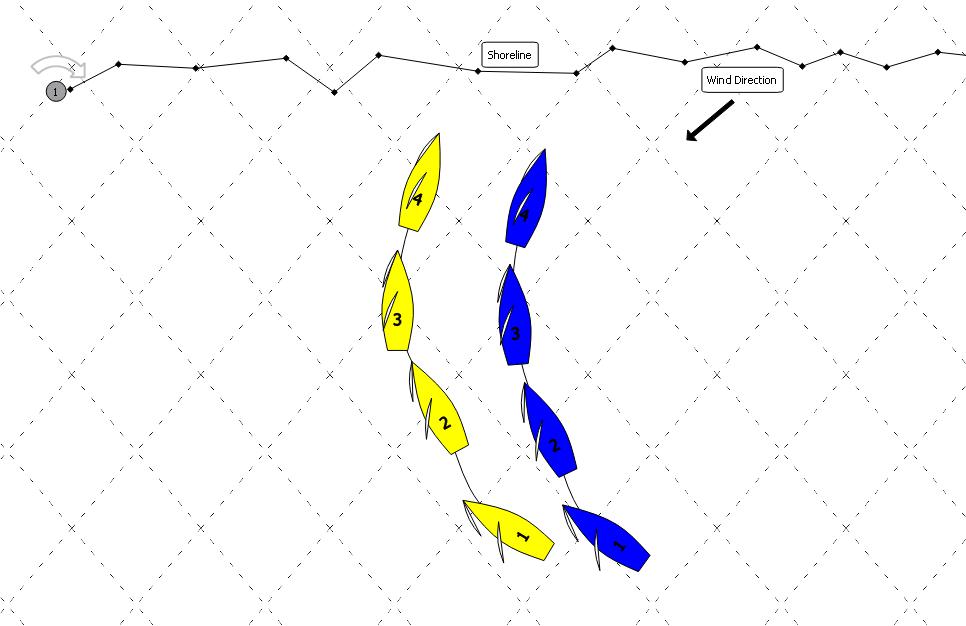 @3 Y is something like exactly 90 degrees to the shoreline, but, as previously discussed, we can't be sure, so last point of certainty is she is overlapped outside B. If B is running out of water, boats are at the obstruction and Y must give B room. @4, Y is clearly past 90 degrees to the shoreline and becomes the inside boat (as in the above MR Call). If Y can get to this position without failing to give B room, she is as good as gold. Consider: this situation is no different from taking a boat the wrong side of the mark, while outside the zone at any ordinary mark. And in match racing flag Y is displayed by a boat to signify a protest, Green and White Flag in response by umpires means no boat is penalised and a penalty is signified by a Blue or Yellow flag corresponding to the colour of the boat penalised
Edited by Brass - 12 Jan 14 at 5:05am |
|
 |
|
SteveB00 
Newbie 
Joined: 30 Nov 13 Location: Sydney, Oz Online Status: Offline Posts: 24 |
 Post Options Post Options
 Quote Quote  Reply Reply
 Posted: 12 Jan 14 at 5:53am Posted: 12 Jan 14 at 5:53am |
|
Yes, this is the situation (except that the wind was a little further aft). I'm kind of surprised that, as long as yellow aims roughly at the mark and blue is "inside", then blue has rights, but if yellow luffs up to the point where she is closer to the obstruction than blue, then she can force blue out, then bear away herself. It may seem difficult for her to do that in your match race diagram but, she may be a bigger boat, and may be further ahead than in the diagram.
A boat can only take another boat the wrong side of a mark if she also goes the wrong side, correct? Here yellow bears away at the last minute to take the mark, but has forced blue to tack and gybe (or tack back) to get there. Thanks for all this, Steve = : ^ )
|
|
 |
|
Post Reply 
|
Page 123> |
| Forum Jump | Forum Permissions  You cannot post new topics in this forum You cannot reply to topics in this forum You cannot delete your posts in this forum You cannot edit your posts in this forum You cannot create polls in this forum You cannot vote in polls in this forum |
Copyright ©2001-2010 Web Wiz
Change your personal settings, or read our privacy policy











 Printable Version
Printable Version Delicious
Delicious Digg
Digg Facebook
Facebook Furl
Furl Google
Google MySpace
MySpace Newsvine
Newsvine reddit
reddit StumbleUpon
StumbleUpon Twitter
Twitter Windows Live
Windows Live Yahoo Bookmarks
Yahoo Bookmarks Topic Options
Topic Options